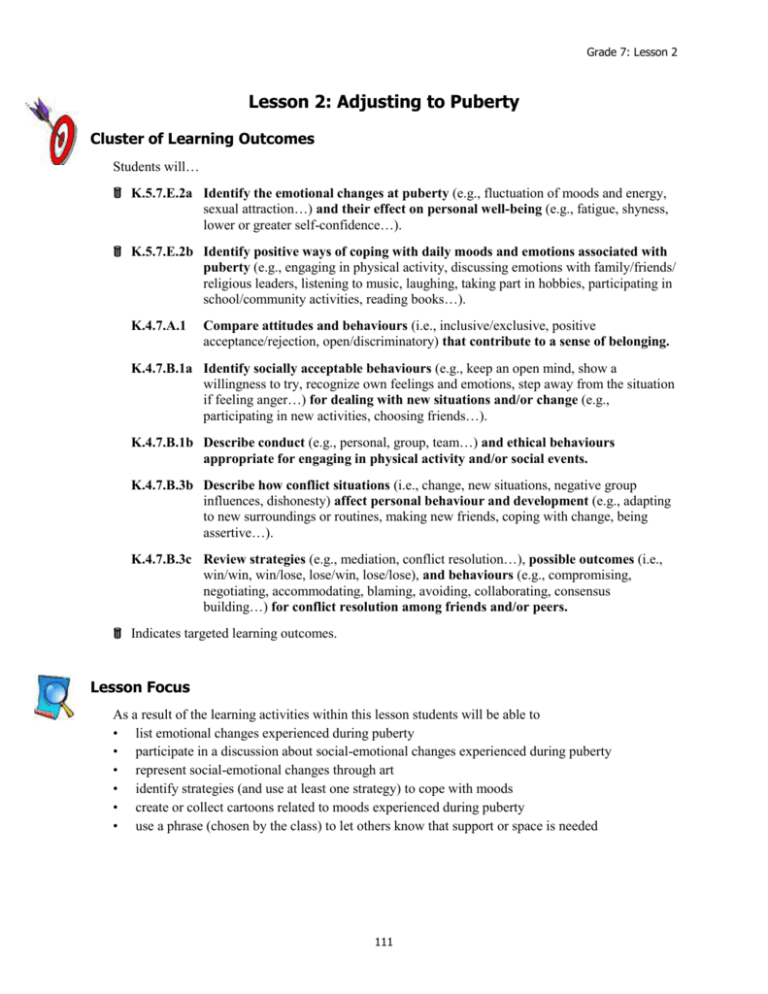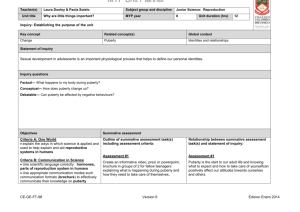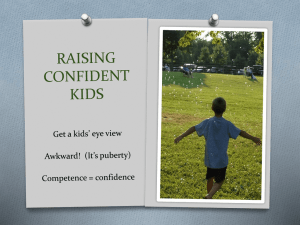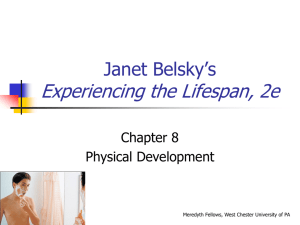
Grade 7: Lesson 2
Lesson 2: Adjusting to Puberty
Cluster of Learning Outcomes
Students will…
K.5.7.E.2a Identify the emotional changes at puberty (e.g., fluctuation of moods and energy,
sexual attraction…) and their effect on personal well-being (e.g., fatigue, shyness,
lower or greater self-confidence…).
K.5.7.E.2b Identify positive ways of coping with daily moods and emotions associated with
puberty (e.g., engaging in physical activity, discussing emotions with family/friends/
religious leaders, listening to music, laughing, taking part in hobbies, participating in
school/community activities, reading books…).
K.4.7.A.1
Compare attitudes and behaviours (i.e., inclusive/exclusive, positive
acceptance/rejection, open/discriminatory) that contribute to a sense of belonging.
K.4.7.B.1a Identify socially acceptable behaviours (e.g., keep an open mind, show a
willingness to try, recognize own feelings and emotions, step away from the situation
if feeling anger…) for dealing with new situations and/or change (e.g.,
participating in new activities, choosing friends…).
K.4.7.B.1b Describe conduct (e.g., personal, group, team…) and ethical behaviours
appropriate for engaging in physical activity and/or social events.
K.4.7.B.3b Describe how conflict situations (i.e., change, new situations, negative group
influences, dishonesty) affect personal behaviour and development (e.g., adapting
to new surroundings or routines, making new friends, coping with change, being
assertive…).
K.4.7.B.3c Review strategies (e.g., mediation, conflict resolution…), possible outcomes (i.e.,
win/win, win/lose, lose/win, lose/lose), and behaviours (e.g., compromising,
negotiating, accommodating, blaming, avoiding, collaborating, consensus
building…) for conflict resolution among friends and/or peers.
Indicates targeted learning outcomes.
Lesson Focus
As a result of the learning activities within this lesson students will be able to
• list emotional changes experienced during puberty
• participate in a discussion about social-emotional changes experienced during puberty
• represent social-emotional changes through art
• identify strategies (and use at least one strategy) to cope with moods
• create or collect cartoons related to moods experienced during puberty
• use a phrase (chosen by the class) to let others know that support or space is needed
111
Grade 7: Lesson 2
Resources
Audiovisual
•
video about puberty—for video choices, search the Manitoba Education, Citizenship and Youth,
Instructional Resources Unit (IRU) Library online catalogue: <http://libcat.merlin.mb.ca>
Print/Publications
•
•
Aboriginal Nurses Association of Canada and Planned Parenthood Federation of Canada. Finding
Our Way: A Sexual and Reproductive Health Sourcebook for Aboriginal Communities.
Ottawa, ON: Aboriginal Nurses Association of Canada and Planned Parenthood Federation of
Canada, 2002.
Planned Parenthood Federation of Canada. Beyond the Basics: A Sourcebook on Sexual and
Reproductive Health Education. Ottawa, ON: Planned Parenthood Federation of Canada,
2001. Available online at: <http://www.ppfc.ca>.
Organization/Website
•
The Society of Obstetricians and Gynaecologists of Canada: <www.sexualityandu.ca>
Notes to Teacher
Lesson Suggestions
•
•
•
Encourage students to talk to trusted adults or friends about what they are experiencing. Keeping
a journal/learning log is also a useful means of self-expression.
Ensure that students show respect for and understanding of anyone who may be sensitive to the
changes associated with puberty.
Be sensitive to the fact that some students may be experiencing same-sex attractions.
Changes Associated with Puberty
Puberty can be a time of great stress and insecurity for adolescents because they experience so many
physical, emotional, and social changes, including those identified below. Moods often shift quickly
and unpredictably. At times, students will shift from mature behaviour to childish behaviour.
Relationships with parents are also often strained as adolescents assert their independence.
Physical Changes:
• Physical changes associated with puberty are addressed in Grade 5, Lesson 2 (see BLM 5-2.1:
Puberty Changes and Answer Key).
Psycho-Social Characteristics:
• Young teens show the need for security and love.
• Strong emotional ties and infatuations may develop.
• Peer popularity, conformity, and acceptance are evident and/or often desired.
• Mixed groups are popular social groupings prior to dating.
• Need for personal recognition and acceptance is evident.
• Fear of rejection by peers may be evident.
• The expression of emotions such as grief, shyness, jealousy, anger, and guilt may intensify.
• New responsibilities and experiences may generate anxiety.
(continued)
_________
Changes Associated with Puberty: Adapted from Family Life Education, Grade 7. Copyright © 1990 by Manitoba Education
and Training.
112
Grade 7: Lesson 2
Notes to Teacher (continued)
Social-Emotional Changes:
• Attitude and behaviour patterns toward the opposite sex change.
• Sexual feelings emerge (may be toward opposite or same sex).
• Search for self-identity and understanding begins.
• Interest in becoming more financially independent of the family begins.
• Family values may be challenged by peer values and ideals.
• Mood swings and self-centredness occur.
• Need for peer acceptance regarding dress, language, behaviour, emotions, and appearance grows
strong.
• Conformity with peer groups increases.
• Need for individual decisions about drugs, sexual activities, and personal values increases.
• Peer groups/cliques (unisexual groups) form.
Curricular Connections
ELA:
GLO 1—Explore thoughts, ideas, feelings, and experiences
GLO 2—Comprehend and respond personally and critically to oral, literary, and media texts
GLO 4—Enhance the clarity and artistry of communication
PE/HE:
GLO 4—Personal and Social Management (K.4.7.A.1, K.4.7.A.2, K.4.7.A.2b, K.4.7.B.1a, K.4.7.B.4)
Family Involvement
•
•
•
Have students ask parents about strategies they have used to help with emotions.
Encourage students to talk to their parents about finding a phrase to use when they feel too
emotional to talk (e.g., “time out”).
Encourage parents to provide their children with appropriate books related to puberty.
Example of Book:
Kelly, Bill. You Ought to Know: A Guy’s Guide to Sex. New York, NY: Rosen Publishing
Group/Rosen Central, 2000.
113
Grade 7: Lesson 2
Suggestions for Instruction
1. Begin the lesson by having students view a section of a video dealing with emotional changes
experienced during puberty. Have students note the changes as they view the video.
2. Draw a T-Chart on the classroom board and
• record students’ suggestions (noted from the video or other ideas) regarding the emotional
changes associated with puberty (e.g., fluctuation of moods and energy, sexual attraction, peer
pressure, worries about being normal)
• indicate how these changes affect personal well-being (e.g., fatigue, shyness, lower or greater
self-confidence)
Example:
Changes
•
•
sexual attraction
increase in confidence
Effects
•
•
shyness
taking more risks
3. Discuss social-emotional changes associated with puberty. Have students create a picture to
represent the emotional changes that occur during puberty (e.g., a roller coaster, abstract shapes, a
heart). Ask for volunteers to share their art and explain why they chose the picture to represent
the emotional changes.
4. Mood Busters: Have students brainstorm for positive ways to cope with daily moods and
emotions associated with puberty.
Examples of Coping Strategies:
• engaging in physical activity
• eating well
• discussing emotions with family/friends/religious leaders
• listening to music
• laughing
• crying
• taking part in hobbies
• participating in school/community activities
• reading books
5. Have students select at least two activities they will do each day for one week. After one week,
have students comment on how the activities affected their mood.
6. Have students create or collect cartoons related to the moods and emotions associated with
puberty. Help students to understand that these changes and moods are normal and that the use of
humour is one way of coping with them.
7. As a class, come up with a phrase that students may use if they are feeling emotional and in need
of support or space. Others can then be sensitive to the situation.
114
Grade 7: Lesson 2
Suggestions for Assessment
Observation
Teacher Assessment: Anecdotal Notes
Observe whether students are able to list emotional changes that occur during puberty and explain
how each affects personal well-being.
Suggested Criteria:
Look for identification and explanation of examples such as
sexual attraction
mood swings
insecurities
need for acceptance from others
pressure to conform with peers
conflicts with family members
need to make more personal decisions
other
Journal/Learning Log: Mood Busters
Self-Assessment: Checklist
Ask students to complete the following sentence starters in relation to positive coping
strategies in response to moods and emotions experienced during puberty:
1. One activity I attempted was…
2. The results of this activity were…
Suggested Criterion:
Have students assess whether they are able to identify at least five positive ways to cope with
moods and emotions associated with puberty.
Yes
No
115
Grade 7: Lesson 2
Notes
116








